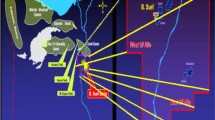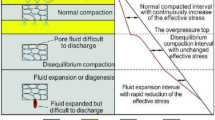Abstract
Pore pressure and stress analysis are vital to avoid well complications while drilling. A methodology was used to map pore pressure in the Raniganj basin located in India using sonic log and seismic data. A model-based seismic inversion technique was used to characterize the reservoir. Moreover, seismic attributes generated from inversion were integrated with estimated pore pressure from Bower’s and Eaton’s method using sonic logs to map sub-surface pore pressure. The probabilistic neural network architecture was used as an integration algorithm for mapping the pore pressure. Besides, the magnitude of overburden (Sv), maximum (SH), and minimum (Sh) horizontal stress were estimated, and the present-day SH direction was determined from drilling-induced fractures in the resistivity image log. Pore pressure equals hydrostatic pressure at shallower depth while marginal overpressure was observed at deeper depth as the estimated pore pressure deviates from the normal compaction trend line. Bower’s method slightly overestimates the pore pressure at deeper depth compared to Eaton’s, though the minimum difference between estimated and measured pore pressure supports the result. Stress analysis identifies a normal fault stress regime (Sv > SH > Sh), in which existing normal faults were stable based on frictional faulting theory. The SH is oriented along NE-SW direction and the estimated Sh magnitude corroborates with direct field measurements. The result from this study helps to understand pore pressure distribution and stress profiles, mitigates associated drilling risk, predicts the pressure limit for the reactivation of existing faults during fluid injection in hydraulic fracturing treatments, and also provides vital inputs for future geomechanical studies.



















Similar content being viewed by others
Data availability
The data that supports the finding in the study is available with the CBM, Bokaro Asset of ONGC, India.
Code availability
Software application.
References
Alabi A, Enikanselu AP (2019) Integrating seismic acoustic impedance inversion and attributes for reservoir analysis over ‘DJ’ field, Niger Delta. J Pet Explor Prod Technol 9:2487–2496. https://doi.org/10.1007/s13202-019-0720-z
Alam J, Chatterjee R, Dasgupta S (2019) Estimation of pore pressure, tectonic strain and stress magnitudes in the Upper Assam basin: a tectonically active part of India. Geophys J Int 216:659–675
Al-Qahtani M, Rahim Z (2001) A mathematical algorithm for modeling geomechanical rock properties of the Khu and Pre-Khu reservoirs in Ghawar field. In: Proceedings of the SPE Annual Technical Conference and Exhibition. Bahrain, pp 123–129
Bahmaei Z, Hosseini E (2020) Pore pressure prediction using seismic velocity modeling: case study, Sefid-Zakhor gas field in Southern Iran. J Pet Explor Prod Technol 10:1051–1062. https://doi.org/10.1007/s13202-019-00818-y
Banerjee A, Chatterjee R (2021) A methodology to estimate proximate and gas content saturation with lithological classification in Coalbed Methane Reservoir, Bokaro Field, India. Nat Resour Res 30:2413–2429. https://doi.org/10.1007/s11053-021-09828-2
Barton CA, Zoback MD (2002) Discrimination of natural fractures from drilling induced wellbore failures in wellbore image data – implication of reservoir permeability. SPE Reservoir Eval Eng 5(3):249–254. https://doi.org/10.2118/78599-PA
Bateman RM (1985) Openhole log analysis and formation evaluation. Pretice Hall PTR, New Jersey, p 647
Bell JS, Gough DI (1979) Northeast-southwest compressive stress in Alberta evidence from oil wells. Earth Planet Sci Lett 45(2):475–482. https://doi.org/10.1016/0012-821X(79)90146-8
Bowers GL (1995) Pore pressure estimation from velocity data; accounting for overpressure mechanism besides undercompaction. SPE Drill Complet 10:89–95. https://doi.org/10.2118/27488-PA
Chang C, Zoback MD et al (2006) Empirical relations between rock strength and physical properties in sedimentary rocks. J Petrol Sci Eng 51:223–237
Chatterjee R, Paul S, Pal PK (2019) Relation between coalbed permeability and in-situ stress magnitude for coalbed methane exploration in Jharia and Raniganj coalfields, India. Lead Edge 38:800–807. https://doi.org/10.1190/tle38100800.1
Coal Atlas of India (1993) Central mine planning and design Institute Ranchi. Coal India
Das B, Chatterjee R (2018) Mapping of pore pressure, in-situ stress and brittleness in unconventional shale reservoir of Krishna-Godavari basin. J Nat Gas Sci Eng 50:74–89. https://doi.org/10.1016/j.jngse.2017.10.021
Dutta NC (2002) Geopressure prediction using seismic data: current status and the road ahead. Geophysics 67(6):2012–2041. https://doi.org/10.1190/1.1527101
Dutta NC (1986) Shale compaction, burial diagenesis, and geopressures: a dynamic model, solution, and some results in thermal modeling in sedimentary basins. In: Burrus J (ed) Thermal Modeling in Sedimentary Basins. Editions Technip, Paris, pp 149–172
Dasgupta S, Chatterjee R, Mohanty SP, Alam J (2019) Pore pressure modelling in a compressional setting: a case study from Assam, NE India. J Pet Geol 4(3):319–338
Eaton BA (1975) The equation for geopressure prediction from well logs. In: 50th Annual Fall Meeting of the Society of Petroleum Engineers of AIME. Paper SPE 5544, Dallas, Texas, pp 11
Engelder T, Fischer MP (1994) Influence of poroelastic behavior on the magnitude of minimum horizontal stress, Sh in overpressured parts of sedimentary basins. Geology 22:949–952
Ganguli SS, Sen S (2020) Investigation of present-day in-situ stresses and pore pressure in the south Cambay Basin, western India: Implications for drilling, reservoir development and fault reactivation. Mar Pet Geol 118:104422
Gao B, Flemings PB (2017) Pore pressure within dipping reservoirs in overpressured basins. Mar Pet Geol 80:94–111
Ghosh SC (2002) The Raniganj Coal Basin: an example of an Indian Gondwana rift. Sed Geol 147:155–176. https://doi.org/10.1016/S0037-0738(01)00195-6
Gutierrez MA, Braunsdor NR, Couzens BA (2006) Calibration and ranking of porepressure prediction models. Leading Edge 25(12):1516–1523
Hampson D, Schuelke J, Quirein J (2001) Use of multi-attribute transforms to predict log properties from seismic data. Geophysics 66:220–236
Hawkes CD, McLellan PJ, Bachu S (2005) Geomechanical factors affecting geological storage of CO2 in depleted oil and gas reservoirs. J Can Pet Technol 44:52–61
Heidbach O, Rajabi M, Cui X, Fuchs K, Müller B, Reinecker J, Reiter K, Tingay M, Wenzel F, Xie F, Ziegler MO, Zoback M-L, Zoback MD (2018) The World Stress Map database release 2016: crustal stress pattern across scales. Tectonophysics 744:484–498
Ju W, Shen J, Qin Y, Meng S, Li C, Li G, Yang G (2018) In-situ stress distribution and coalbed methane reservoir permeability in the Linxing area, eastern Ordos Basin, China. Front Earth Sci 12(3):545–554
Khademian Z, Shahriar K, Nik MG (2012) Developing an algorithm to estimate in situ stresses using a hybrid numerical method based on local stress measurement. Int J Rock Mech Min Sci 55:80–85. https://doi.org/10.1016/j.ijrmms.2012.05.019
Kidambi T, Kumar GS (2016) Mechanical earth modeling for a vertical well drilled in a naturally fractured tight carbonate gas reservoir in the Persian Gulf. J Petrol Sci Eng 141:38–51
Lavergne M, Willim C (1977) Inversion of seismogram and pseudo velocity logs. Geophys Prospect 25:231–250. https://doi.org/10.1111/j.1365-2478.1977.tb01165.x
Law BE, Spencer CW (1998) Abnormal pressure in hydrocarbon environments. AAPG Mem 70:1–11
Liu R, Liu J, Zhu W, Hao F, Xie Y, Wang Z, Wang L (2016) In situ stress analysis in the Yinggehai Basin, northwestern South China Sea: implication for the pore pressure-stress coupling process. Mar Pet Geol 77:341–352
Mallick S (1995) Model-based inversion of amplitude-variations-with-offset data using a genetic algorithm. Geophysics 60(4):939–954
Masters T (1995) Advanced algorithms for neural networks. John Wiley and Sons
Meng Z, Zhang J, Wang R (2011) In-situ stress, pore pressure and stress-dependent permeability in the Southern Qinshui Basin. Int J Rock Mech Min Sci 48(1):122–131
Mohebali B, Tahmassebi A, Mayer-Baese A, Gandomi AK (2020) Probabilistic neural networks: a brief overview of theory, implementation, and application. Handbook of Probabilistic Models 347–367. https://doi.org/10.1016/B978-0-12-816514-0.00014-X
Najibi AR, Ghafoori M, Lashkaripour GR, Asef MR (2017) Reservoir geomechanical modeling: in-situ stress, pore pressure, and mud design. J Petrol Sci Eng 151:31–39
Plumb RA, Evans KF, Engelder T (1991) Geophysical log responses and their correlation with bed to bed stress contrasts in Paleozoic rocks, Appalachian Plateau, New York. J Geophys Res 96(B9):14509–14528
Reis A, Bezerra FH, Ferreira JM, Nascimento AFdo, Lima CC (2013) Stress magnitude and orientation in the Potiguar Basin, Brazil: implications on faulting style and reactivation. J Geophys Res 118:1–14. https://doi.org/10.1002/2012JB009953
Russell B, Hampson DA (1991) Comparison of poststack seismic inversion methods. In: 61st Annual International Meeting, Society of exploration geophysicists. pp 876–878
Saggaf MM, Toksoz MN, Mustafa HM (2003) Estimation of reservoir properties from seismic data by smooth neural networks. Geophysics 68:1969–1983. https://doi.org/10.1190/1.1635051
Saxena V, Krief M, Adam L (2018) Handbook of borehole acoustics and rock physics for reservoir characterization. Elsevier. https://doi.org/10.1016/C2016-0-03411-3
Specht D (1990) Probabilistic neural networks. Neural Netw 3:109–118
Swarbrick RE, Osborne MJ (1998) Mechanisms that generate abnormal pressures: an overview. In: Law BE, Ulmishek GF, Slavin VI (eds) Abnormal pressures in hydrocarbon environments. AAPG Memoir, 70:13–34
Swarbrick RE, Osborne MJ, Yardley GS (2002) Comparison of overpressure magnitude resulting from the main generating mechanisms. In: Huffman AR, Bowers GL (eds) Pressure regimes in sedimentary basins and their prediction. AAPG Memoir, 76:1–12
Taghipour M, Ghafoori M, Lashkaripour GR, Mohgaddas NH, Molaghab A (2019) Estimation of the current stress field and fault reactivation analysis in the Asmari reservoir, SW Iran. Pet Sci 16:513–526. https://doi.org/10.1007/s12182-019-0331-9
Terzaghi K (1943) Theoretical Soil Mechanics. Wiley, New York. https://doi.org/10.1002/9780470172766
Tingay M, Müller B, Reinecker J, Heidbach O, Wenzel F, Fleckenstein P (2005) Understanding tectonic stress in the oil patch: the world stress map project. Lead Edge 24(12):1276–1282
Tingay MRP, Hillis RR, Swarbrick RE, Morley CK, Damit AR (2009) Origin of overpressure and pore pressure prediction in the Baram province, Brunie. AAPG Bull 93:51–74
Tingay MRP, Morley CK, Laird A, Limpornpipat O, Krisadasima K, Pabchanda S, Macintyre HR (2013) Evidence for overpressure generation by kerogen-to-gas maturation in the northern Malay basin. AAPG Bull 97:639–672
Trautwein-Bruns U, Schulze KC, Becker S, Kukla PA, Urai JL (2010) In situ stress variations at the variscan deformation front - results from the deep Aachen geothermal well. Techtonophysics 493(1–2):196–211. https://doi.org/10.1016/j.tecto.2010.08.003
Verleysen M, Francois D (2005) The curse of dimensionality in data mining and time series prediction. In: International Work-Conference on Artificial Neural Networks. Springer, pp 758–770
Wang HF (2000) Theory of linear poroelasticity with applications to geomechanics and hydrogeology. Princeton University Press, pp 304
Zhang J (2011) Pore pressure prediction from well logs: methods, modifications, and new approaches. Earth Sci Rev 108:1–33
Zoback M, Barton C, Brudy M, Castillo D, Finkbeiner T, Grollimund B, Wiprut D (2003) Determination of stress orientation and magnitude in deep wells. Int J Rock Mech Min Sci 40(7):1049–1076
Acknowledgements
The authors are grateful to Oil and Natural Gas Corporation Limited, India, for providing permission to present the paper. We thank the Department of Applied Geophysics, Indian Institute of Technology (Indian School of Mines), Dhanbad, for helping us in conducting the study. The authors also wish to record the help and guidance rendered by Mr. A.K Dwivedi (Ex-Director (Exploration) and Mr. N.C. Pandey (Ex-Director (T&FS) of ONGC. Authors acknowledge financial support from SERB/IMP/2018/000369 project.
Author information
Authors and Affiliations
Contributions
Abir Banerjee: conceptualization, methodology, software, data curation, writing—original draft preparation. Rima Chatterjee: supervision, writing—reviewing and editing.
Corresponding author
Ethics declarations
Conflict of interest
The authors declare no competing interests.
Rights and permissions
About this article
Cite this article
Banerjee, A., Chatterjee, R. Pore pressure modeling and in situ stress determination in Raniganj basin, India. Bull Eng Geol Environ 81, 49 (2022). https://doi.org/10.1007/s10064-021-02502-0
Received:
Accepted:
Published:
DOI: https://doi.org/10.1007/s10064-021-02502-0




